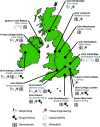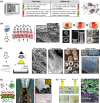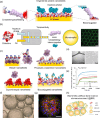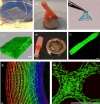Biofabrication and biomanufacturing in Ireland and the UK
- PMID: 39650072
- PMCID: PMC11618173
- DOI: 10.1007/s42242-024-00316-z
Biofabrication and biomanufacturing in Ireland and the UK
Abstract
As we navigate the transition from the Fourth to the Fifth Industrial Revolution, the emerging fields of biomanufacturing and biofabrication are transforming life sciences and healthcare. These sectors are benefiting from a synergy of synthetic and engineering biology, sustainable manufacturing, and integrated design principles. Advanced techniques such as 3D bioprinting, tissue engineering, directed assembly, and self-assembly are instrumental in creating biomimetic scaffolds, tissues, organoids, medical devices, and biohybrid systems. The field of biofabrication in the United Kingdom and Ireland is emerging as a pivotal force in bioscience and healthcare, propelled by cutting-edge research and development. Concentrating on the production of biologically functional products for use in drug delivery, in vitro models, and tissue engineering, research institutions across these regions are dedicated to innovating healthcare solutions that adhere to ethical standards while prioritising sustainability, affordability, and healthcare system benefits.
随着我们从第四次工业革命向第五次工业革命的过渡,生物制造领域的兴起正在改变生命科学和医疗保健。3D生物打印、组织工程、定向组装和自组装等先进技术在创建仿生支架、组织类器官、医疗设备和生物系统方面发挥着重要作用。英国和爱尔兰的生物制造领域成为生物科学和医疗保健的关键力量,得益于尖端的研究和发展。这些地区的研究专注于药物输送、体外模型, 类器官,和组织工程的生物功能产品,致力于创新符合伦理标准的医疗保健解决方案,同时支持环保和有效的医疗保健系统。.
Keywords: Biohybrid; Biomaterials; Bioprinting; Drug delivery; Sustainability; Tissue engineering.
© The Author(s) 2024.
Conflict of interest statement
Conflict of interestYYSH is an associate editor for Bio-Design and Manufacturing and was not involved in the editorial review or the decision to publish this article. The authors declare that they have no conflict of interest.
Figures















References
-
- Xu M, David JM, Kim SH (2018) The Fourth Industrial Revolution: opportunities and challenges. Int J Financ Res 9(2):90–95. 10.5430/ijfr.v9n2p90
-
- Office for National Statistics (2024) National Life Tables—Life Expectancy in the UK: 2020 to 2022. Statistical Bulletin. https://www.ons.gov.uk/peoplepopulationandcommunity/birthsdeathsandmarri...
-
- Bosurgi R (2019) Climate crisis: healthcare is a major contributor, global report finds. BMJ 336:l5560. 10.1136/bmj.l5560 - PubMed
-
- Global Carbon Project (2019) Supplemental Data of Global Carbon Project 2019. Global Carbon Project. 10.18160/GCP-2019
-
- Taylor K, Alvarez LR (2019) An estimate of the number of animals used for scientific purposes worldwide in 2015. Altern Lab Anim 47(5–6):196–213. 10.1177/0261192919899853 - PubMed
Publication types
LinkOut - more resources
Full Text Sources
Research Materials
